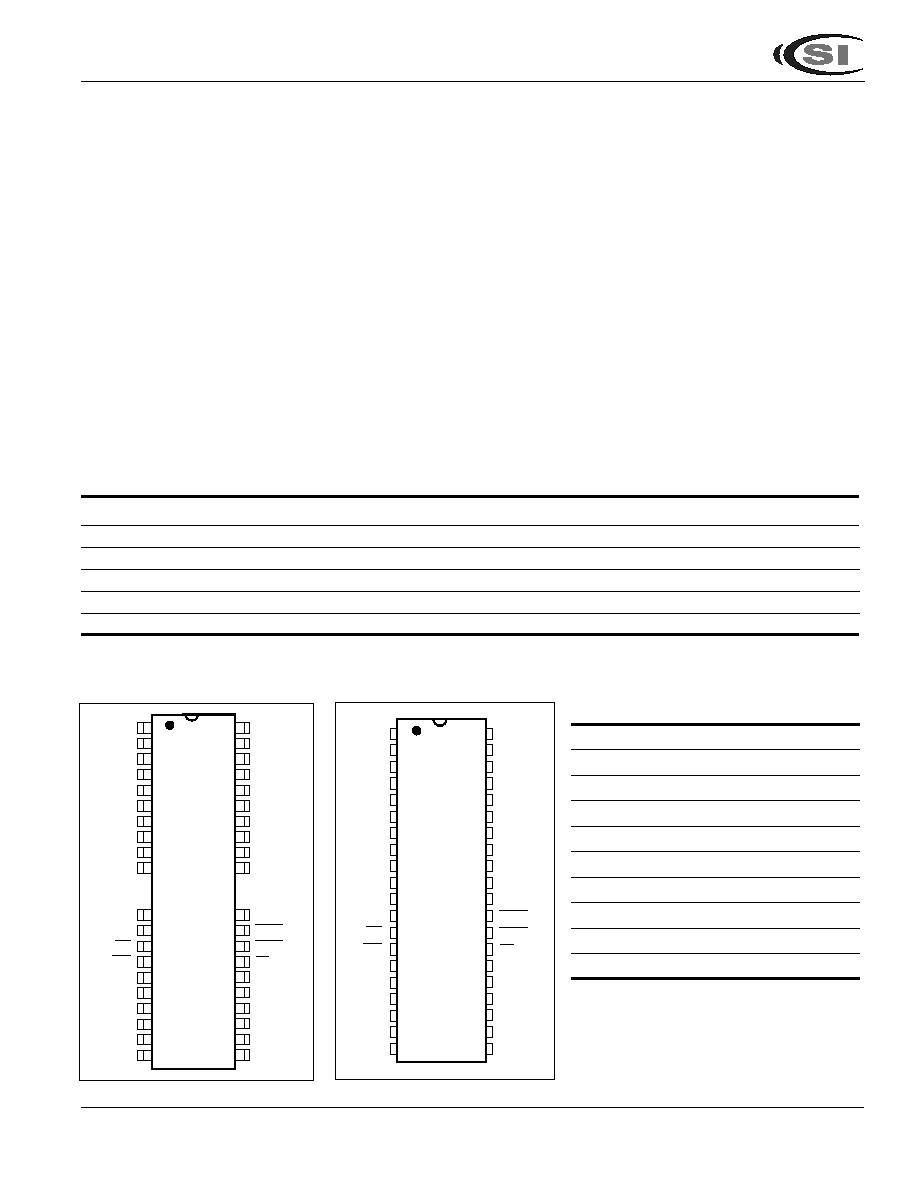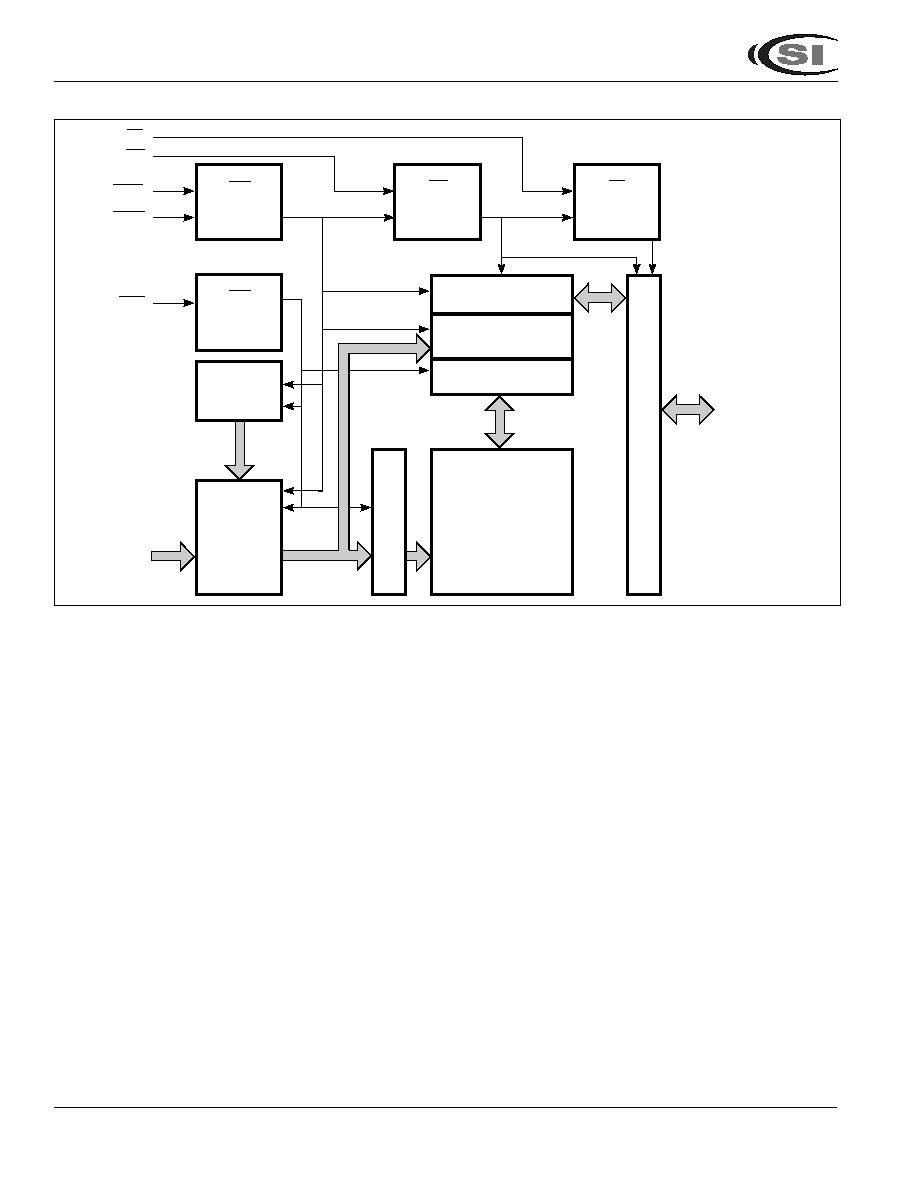
IS41C16256
IS41LV16256
Integrated Circuit Solution Inc.
1
DR001-0E 01/25/2002
ICSI reserves the right to make changes to its products at any time without notice in order to improve design and supply the best possible product. We assume no responsibility for any errors
which may appear in this publication. © Copyright 2000, Integrated Circuit Solution Inc.
FEATURES
· Extended Data-Out (EDO) Page Mode access cycle
· TTL compatible inputs and outputs; tristate I/O
· Refresh Interval: 512 cycles /8 ms
· Refresh Mode:
RAS
-Only,
CAS
-before-
RAS
(CBR),
Hidden
· Single power supply:
5V
±
10% (IS41C16256)
3.3V
±
10% (IS41LV16256)
· Byte Write and Byte Read operation via two
CAS
· Industrial Temperature Range -40
o
C to 85
o
C
DESCRIPTION
The
ICSI
IS41C16256 and IS41LV16256 is a 262,144 x 16-
bit high-performance CMOS Dynamic Random Access Memo-
ries. The IS41C16256 offer an accelerated cycle access
called EDO Page Mode. EDO Page Mode allows 512 random
accesses within a single row with access cycle time as short
as 10 ns per 16-bit word. The Byte Write control, of upper and
lower byte, makes the IS41C16256 ideal for use in
16-, 32-bit wide data bus systems.
These features make the IS41C16256and IS41LV16256 ideally
suited for high-bandwidth graphics, digital signal processing,
high-performance computing systems, and peripheral
applications.
The IS41C16256 is packaged in a 40-pin 400mil SOJ and
400mil TSOP-2.
256K x 16 (4-MBIT) DYNAMIC RAM
WITH EDO PAGE MODE
KEY TIMING PARAMETERS
Parameter
-25(5V)
-35
-50
-60
Unit
Max.
RAS
Access Time (t
RAC
)
25
35
50
60
ns
Max.
CAS
Access Time (t
CAC
)
10
10
14
15
ns
Max. Column Address Access Time (t
AA
)
12
18
25
30
ns
Min. EDO Page Mode Cycle Time (t
PC
)
10
12
20
25
ns
Min. Read/Write Cycle Time (t
RC
)
45
60
90
110
ns
40-Pin SOJ
PIN CONFIGURATIONS
40-Pin TSOP-2
1
2
3
4
5
6
7
8
9
10
11
12
13
14
15
16
17
18
19
20
40
39
38
37
36
35
34
33
32
31
30
29
28
27
26
25
24
23
22
21
VCC
I/O0
I/O1
I/O2
I/O3
VCC
I/O4
I/O5
I/O6
I/O7
NC
NC
WE
RAS
NC
A0
A1
A2
A3
VCC
GND
I/O15
I/O14
I/O13
I/O12
GND
I/O11
I/O10
I/O9
I/O8
NC
LCAS
UCAS
OE
A8
A7
A6
A5
A4
GND
PIN DESCRIPTIONS
A0-A8
Address Inputs
I/O0-15
Data Inputs/Outputs
WE
Write Enable
OE
Output Enable
RAS
Row Address Strobe
UCAS
Upper Column Address Strobe
LCAS
Lower Column Address Strobe
Vcc
Power
GND
Ground
NC
No Connection
1
2
3
4
5
6
7
8
9
10
11
12
13
14
15
16
17
18
19
20
40
39
38
37
36
35
34
33
32
31
30
29
28
27
26
25
24
23
22
21
VCC
I/O0
I/O1
I/O2
I/O3
VCC
I/O4
I/O5
I/O6
I/O7
NC
NC
WE
RAS
NC
A0
A1
A2
A3
VCC
GND
I/O15
I/O14
I/O13
I/O12
GND
I/O11
I/O10
I/O9
I/O8
NC
LCAS
UCAS
OE
A8
A7
A6
A5
A4
GND

IS41C16256
IS41LV16256
4
Integrated Circuit Solution Inc.
DR001-0E 01/25/2002
Functional Description
The IS41C16256 and IS41LV16256 is a CMOS DRAM
optimized for high-speed bandwidth, low power applica-
tions. During READ or WRITE cycles, each bit is uniquely
addressed through the 18 address bits. These are en-
tered 9 bits (A0-A8) at a time. The row address is latched
by the Row Address Strobe (
RAS
). The column address
is latched by the Column Address Strobe (
CAS
).
RAS
is
used to latch the first nine bits and
CAS
is used the latter
nine bits.
The IS41C16256 and IS41LV16256 has two
CAS
controls,
LCAS
and
UCAS
. The
LCAS
and
UCAS
inputs internally
generates a
CAS
signal functioning in an identical man-
ner to the single
CAS
input on the other 256K x 16
DRAMs. The key difference is that each
CAS
controls its
corresponding I/O tristate logic (in conjunction with
OE
and
WE
and
RAS
).
LCAS
controls I/O0 through I/O7 and
UCAS
controls I/O8 through I/O15.
The IS41C16256 and IS41LV16256
CAS
function is
determined by the first
CAS
(
LCAS
or
UCAS
) transitioning
LOW and the last transitioning back HIGH. The two
CAS
controls give the IS41C16256 both BYTE READ and
BYTE WRITE cycle capabilities.
Memory Cycle
A memory cycle is initiated by bring
RAS
LOW and it is
terminated by returning both
RAS
and
CAS
HIGH. To
ensures proper device operation and data integrity any
memory cycle, once initiated, must not be ended or
aborted before the minimum t
RAS
time has expired. A new
cycle must not be initiated until the minimum precharge
time t
RP
, t
CP
has elapsed.
Read Cycle
A read cycle is initiated by the falling edge of
CAS
or
OE
,
whichever occurs last, while holding
WE
HIGH. The
column address must be held for a minimum time specified
by t
AR
. Data Out becomes valid only when t
RAC
, t
AA
, t
CAC
and t
OEA
are all satisfied. As a result, the access time is
dependent on the timing relationships between these
parameters.
Write Cycle
A write cycle is initiated by the falling edge of
CAS
and
WE
, whichever occurs last. The input data must be valid
at or before the falling edge of
CAS
or
WE
, whichever
occurs first.
Refresh Cycle
To retain data, 512 refresh cycles are required in each
8 ms period. There are two ways to refresh the memory.
1. By clocking each of the 512 row addresses (A0 through
A8) with
RAS
at least once every 8 ms. Any read, write,
read-modify-write or
RAS
-only cycle refreshes the
addressed row.
2. Using a
CAS
-before-
RAS
refresh cycle.
CAS
-before-
RAS
refresh is activated by the falling edge of
RAS
,
while holding
CAS
LOW. In
CAS
-before-
RAS
refresh
cycle, an internal 9-bit counter provides the row ad-
dresses and the external address inputs are ignored.
CAS
-before-
RAS
is a refresh-only mode and no data
access or device selection is allowed. Thus, the output
remains in the High-Z state during the cycle.
Extended Data Out Page Mode
EDO page mode operation permits all 512 columns within
a selected row to be randomly accessed at a high data
rate.
In EDO page mode read cycle, the data-out is held to the
next
CAS
cycle's falling edge, instead of the rising edge.
For this reason, the valid data output time in EDO page
mode is extended compared with the fast page mode. In
the fast page mode, the valid data output time becomes
shorter as the
CAS
cycle time becomes shorter. Therefore,
in EDO page mode, the timing margin in read cycle is
larger than that of the fast page mode even if the
CAS
cycle
time becomes shorter.
In EDO page mode, due to the extended data function, the
CAS
cycle time can be shorter than in the fast page mode
if the timing margin is the same.
The EDO page mode allows both read and write opera-
tions during one
RAS
cycle, but the performance is
equivalent to that of the fast page mode in that case.
Power-On
After application of the V
CC
supply, an initial pause of
200 µs is required followed by a minimum of eight initial-
ization cycles (any combination of cycles containing a
RAS
signal).
During power-on, it is recommended that
RAS
track with
V
CC
or be held at a valid V
IH
to avoid current surges.

IS41C16256
IS41LV16256
Integrated Circuit Solution Inc.
5
DR001-0E 01/25/2002
ABSOLUTE MAXIMUM RATINGS
(1)
Symbol
Parameters
Rating
Unit
V
T
Voltage on Any Pin Relative to GND
5V
1.0 to +7.0
V
3.3V
0.5 to +4.6
V
CC
Supply Voltage
5V
1.0 to +7.0
V
3.3V
0.5 to +4.6
I
OUT
Output Current
50
mA
P
D
Power Dissipation
1
W
T
A
Commercial Operation Temperature
0 to +70
°C
Industrial Operationg Temperature
40 to +85
°C
T
STG
Storage Temperature
55 to +125
°C
Note:
1. Stress greater than those listed under ABSOLUTE MAXIMUM RATINGS may cause permanent
damage to the device. This is a stress rating only and functional operation of the device at these
or any other conditions above those indicated in the operational sections of this specification is
not implied. Exposure to absolute maximum rating conditions for extended periods may affect
reliability.
RECOMMENDED OPERATING CONDITIONS
(Voltages are referenced to GND.)
Symbol
Parameter
Min.
Typ.
Max.
Unit
V
CC
Supply Voltage
5V
4.5
5.0
5.5
V
3.3V
3.0
3.3
3.6
V
IH
Input High Voltage
5V
2.4
--
V
CC
+ 1.0
V
3.3V
2.0
--
V
CC
+ 0.3
V
IL
Input Low Voltage
5V
1.0
--
0.8
V
3.3V
0.3
--
0.8
T
A
Commercial Ambient Temperature
0
--
70
°C
Industrial Ambient Temperature
40
--
85
°C
CAPACITANCE
(1,2)
Symbol
Parameter
Max.
Unit
C
IN
1
Input Capacitance: A0-A8
5
pF
C
IN
2
Input Capacitance:
RAS
,
UCAS
,
LCAS
,
WE
,
OE
7
pF
C
IO
Data Input/Output Capacitance: I/O0-I/O15
7
pF
Notes:
1. Tested initially and after any design or process changes that may affect these parameters.
2. Test conditions: T
A
= 25°C, f = 1 MHz.




